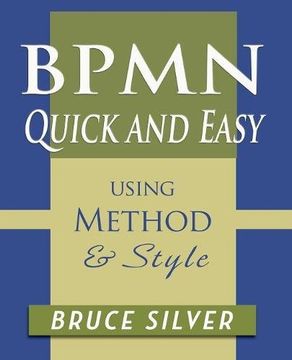Bpmn Quick and Easy Using Method and Style: Process Mapping Guidelines and Examples Using the Business Process Modeling Standard (en Inglés)
Reseña del libro "Bpmn Quick and Easy Using Method and Style: Process Mapping Guidelines and Examples Using the Business Process Modeling Standard (en Inglés)"
BPMN 2.0 is the industry standard diagramming language for business process models. The meaning of the shapes and symbols is defined by a specification, independent of the tool employed. But creating models that communicate the process logic clearly and completely demands more than a dictionary of shapes and symbols. It also requires a methodology for properly structuring the process information and additional best practices specified as "style rules" that can be validated in a tool: Method and Style.Based on training over 4000 students, this book zeroes in on the elements process modelers need to know in order to create Good BPMN: usage of the important shapes and symbols; the Method, a systematic procedure for translating process details gathered in stakeholder workshops into properly structured models that communicate the process logic clearly and completely; and style rules, additional conventions that make the process logic evident from the printed diagrams alone. Chapter 1, What Is BPMN?, discusses key differences between BPMN and traditional flowcharts, and explains the limitations of BPMN. It explains the real meaning of BPMN’s most fundamental concepts – activity and process – and the issues that arise when BPM Architecture and other segments of the BPM domain use those terms much more loosely. Chapter 2, BPMN by Example, builds up an order process bit by bit using elements of the Level 1 working set, illustrating basic usage of tasks and subprocesses, start and end events, gateways, pools, and lanes, and message flow, plus the basics of Method and Style, including process levels and end states, with label matching between gateways in the parent level and end states in the child level. Chapter 3, The Method, describes a systematic procedure that deals with the real challenge of process modeling, turning process details gathered from stakeholder workshops into properly structured BPMN that communicates the process logic clearly. Chapter 4, BPMN Style, explains the most important style rules, illustrating both violations and correct BPMN style. Chapter 5, DMN and Decision Tasks, discusses why embedding decision logic in process models as a chain of gateways is Bad BPMN, and how integrating BPMN with the new companion standard DMN fixes the problem. Chapter 6, Parallel Flow, explains proper merging of sequence flows, depending upon whether they are exclusive alternatives, unconditionally parallel, or conditionally parallel. Chapter 7, Events, discusses common usage patterns with Timer, Message, and Error events. Using intermediate events and event subprocesses, eaders learn how to model deadline-triggered actions, wait for a message or a timeout, handle cancellation or update of a process in flight, and use error throw-catch patterns. Chapter 8, Instance Alignment, deals with the spec’s requirement that the instance of every activity in a BPMN process must correspond 1:1 with the process instance. Since batching is commonplace in real processes, this chapter discusses various ways to handle it: loop and multi-instance activities, multi-process structures, and non-interrupting event subprocesses. Chapter 9, Becoming Proficient, discusses how to go beyond “book learning” and become really proficient at Good BPMN. It takes practice, testing your understanding, and hands-on experience with real tools. Bruce Silver is the leading provider of BPMN training and certification. He has been providing BPMN training since early 2007 and is regarded as an authority in the field. He was a member of the BPMN 2.0 technical committee in OMG, and his methodandstyle.com website is a popular source of news and commentary about all matters related to BPMN.

